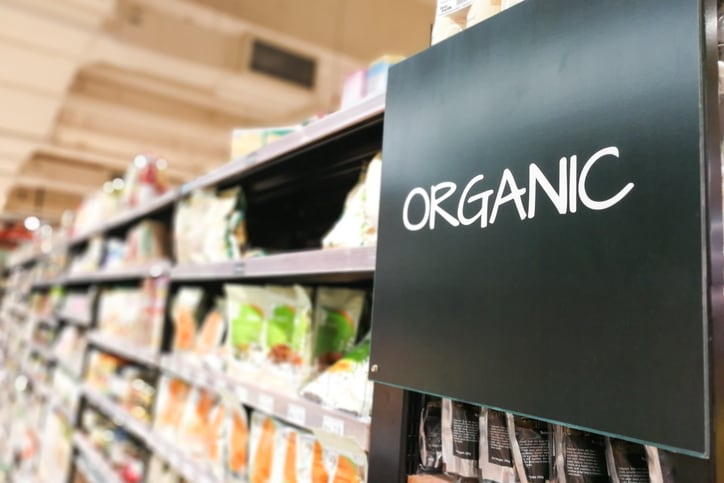Chapman’s appointment, which was announced March 29 at OTA’s 2022 Organic Week conference in Washington, DC, will officially begin April 18 and follows a year-long planned succession for Batcha, who joined OTA in 2008 and served as CEO and executive director for the past nine years.
During this time, Batcha helped shape key legislative and marketing efforts that made organic one of the fastest-growing segments of US agriculture worth $62b today – nearly double the $32b that it represented when Batcha joined OTA.
“There has been so much growth. There has been so much change. Organic has become so much bigger because of Laura,” in part because for her, leading OTA it is not just a job, but something that she “truly lives,” Paul Schiefer, OTA board president and senior director of sustainability for Amy’s Kitchen, told attendees at the trade group’s conference.
For example, he noted Batcha’s time as an organic farmer and entrepreneur before joining OTA, as well as the fundamental changes she made within the trade group and larger industry since joining OTA, including fostering deeper connections with the members and community through section councils and task forces that took on new policy areas, such as international trade, climate resilience and systemic racism in the food and farm system.
Chapman brings ‘realistic and pragmatic’ style to tackle industry challenges
While Batcha helped strengthen OTA and the broader organic industry, both face significant challenges that will require Chapman, as the new leader, to pull on his experience across the organic value chain – most recently as senior director of supply chain at Kinder’s Sauce and Seasonings and before that in positions at Clif Bar and Quality Assurance International and as chair of the National Organic Standards Board and a member of the California Organic Products Advisory Committee at the California Department of Agriculture.
With a self-described “realistic and pragmatic style to work,” Chapman acknowledged his experience at NOSB and “close and collaborative relationships with USDA” will be fundamental in the coming months and years as OTA tries to elevate industry standards to more accurately reflect and meet consumers’ evolving expectations.
Pushing forward updates to the organic food standards has been a sticking point for OTA in recent years with many recommendations made by NOSB to improve the National Organic Program becoming stuck in limbo – some for as long as ten years. These include recommendations to protect genetic integrity of seeds and to clarify the use of vaccines in livestock as well as recommendations for mushroom production made as long ago as 19 years.
Last year, the Continuous Improvement and Accountability in Organic Standards Act was introduced by members of the House Organic Cacus to require USDA to issue a final rule implementing within two years recommendations passed by NOSB.
At a House Committee on Agriculture Subcommittee on Biotechnology, Horticulture and Research hearing March 29, Batcha called on legislators to include in the upcoming Farm Bill a reintroduction of this legislation “with a focus on institutionalizing a more stable future for organic” and an eye towards enhanced oversight and enforcement and continuous improvement.
“We believe the structure of the NOP should be updated to allow for prioritizing standards and market development along with maintaining strong compliance and enforcement,” Batcha said in her testimony.
She added: “Specific funding and resources must be allocated for standards development and implementation at the NOP. There should be a clear requirement for USDA to review and update organic practice standards beyond just the National List of allowed and prohibited substances used in organic.”
Organic is earning a ‘gentleman’s C’ for climate smart benefits
Even as the trade group and industry push to finalize recommendations made long-ago, it also needs to “get in front of” several emerging trends that threaten to “disenfranchise” the organic industry if not addressed quickly, warned Kathleen Merrigan, executive director of the ASU Swette Center for Sustainable Food Systems and the former US deputy secretary of agriculture on continuous improvement and advancement of organic.
For example, she noted consumers’ and the government’s interest in advancing “climate smart” food production systems, including USDA’s promise in February to invest $1b in partnerships to support America’s climate-smart farmers, ranchers and forest landowners, should be an opportunity for expanding organic, but currently the industry is being overlooked.
“I’m really anxious about the climate stuff going on, and I don’t see organic necessarily seated at that table in a very real meaningful way. And USDA is on the brink of and already has put out a lot of new money, and I’m worried that new money will disenfranchise the organic world,” unless the industry better communicates that organic is the original climate smart label, she said.
As a professor, Merrigan said, if she were to grade the industry’s communication about its positive impact on climate she would, at best, give it a “gentleman’s C.”
While she acknowledged this may seem “harsh,” she also noted it is only “midsemester” and there is still time for the industry to step up. And one way she would like to see that done is by amending the certified organic seal to highlight it as climate smart.
OTA urges next farm bill to connect dots between organic and climate smart
In Batcha’s testimony to the House Agriculture subcommittee, she reiterated the need for legislative help promoting organic agriculture as a regenerative system that advances sustainability through crop rotation, cover cropping, building soil health, increasing biodiversity and reducing nutrient pollution.
“Many agronomists, extension agents, NRCS staff and farm consultants lack in the knowledge and understanding of organic systems making them ill-equipped to support organic farmers and those interested in adopting organic practices,” she explained.
As such, she asked for additional funding and incentives to encourage transition to organic, increased processing and infrastructure capacity and help stabilizing supply chains by facilitating more domestic production of targeted organic crops where market demand exceeds supply.
Batcha also called for more support for the Organic Research and Education Initiative and the Organic Certification Cost-Share Program, and increased funding for the Market Access Program, Foreign Market Development Program and Technical Assistance for Specialty Crops to provide US organic businesses with export opportunities and reduced trade barriers.
Finally, she suggested several programmatic changes to the existing farm bill related to organic certification cost-share, crop insurance, conservation, risk management and other farm bill programs.
Organic players must team with those who have ‘shared agenda’
As OTA pursues legislative support and funding for the organic industry, Merrigan said stakeholders must reach out to others across industries with whom they share values and goals to better communicate the full breadth of what organic represents.
For example, she said the organic industry needs to better align itself and work with colleagues in the environmental communities, the consumer advocacy community, groups fighting for better federal minimum wage, public health advocates trying to increase Supplemental Nutrition Assistance Program benefits and others “because we have a shared agenda.”
These efforts would also help communicate to consumers the value proposition of organic, many attributes of which currently are lost under the umbrella branding.




